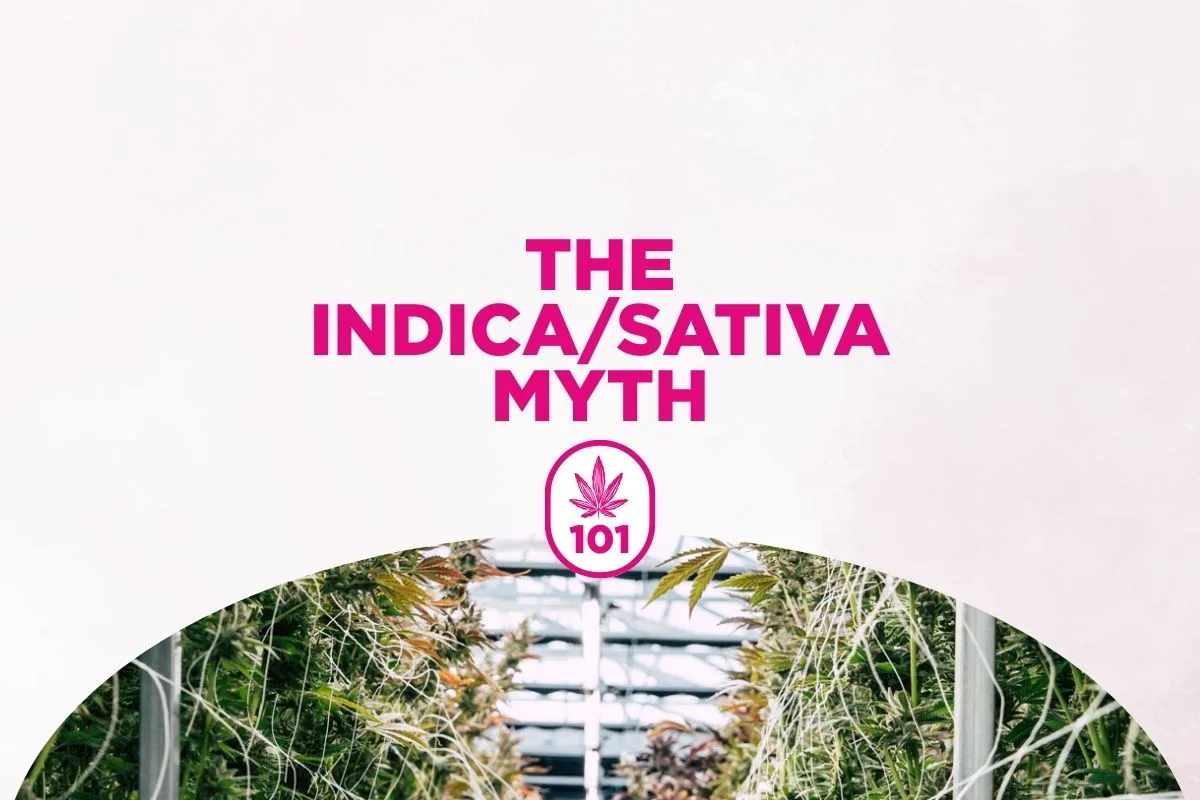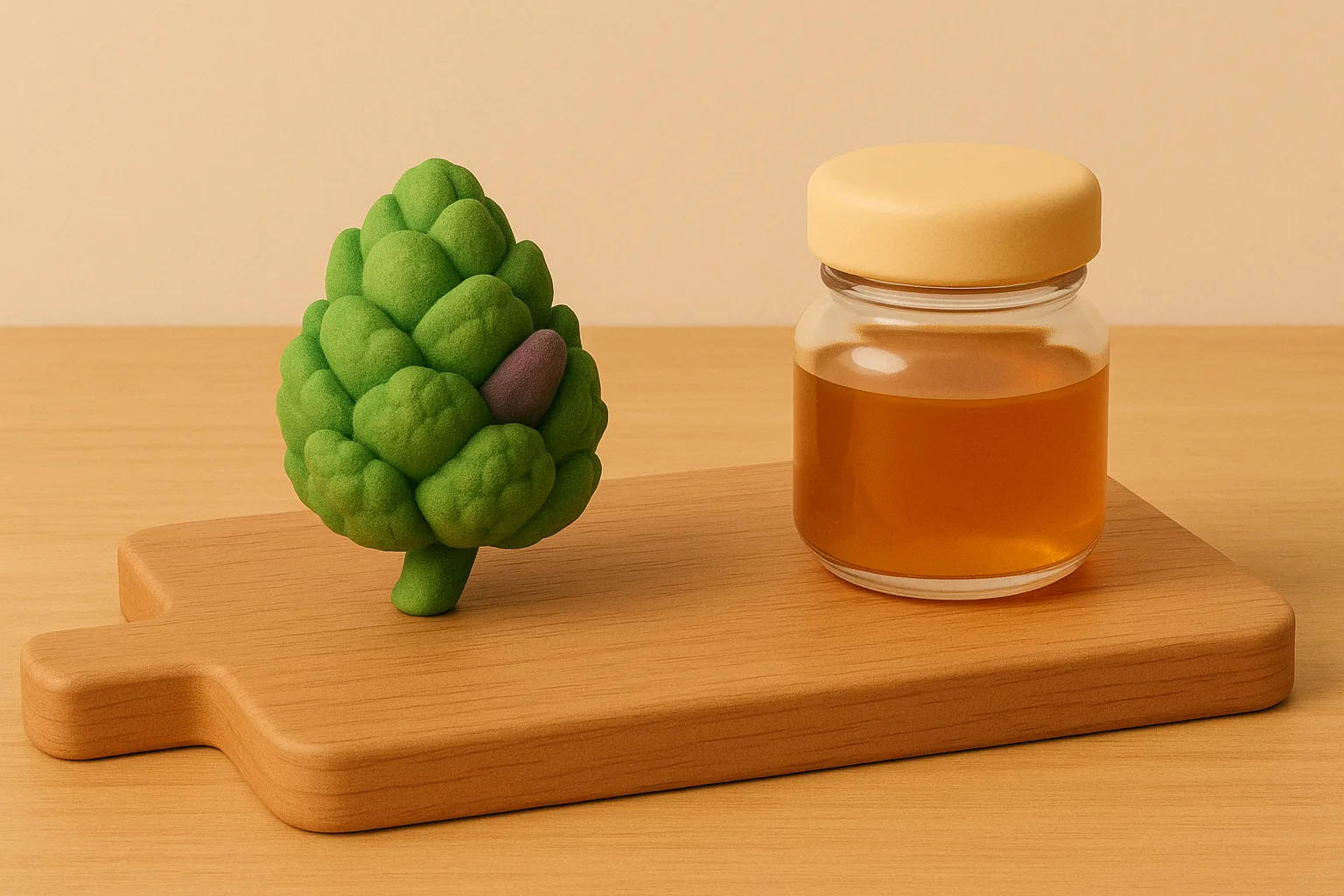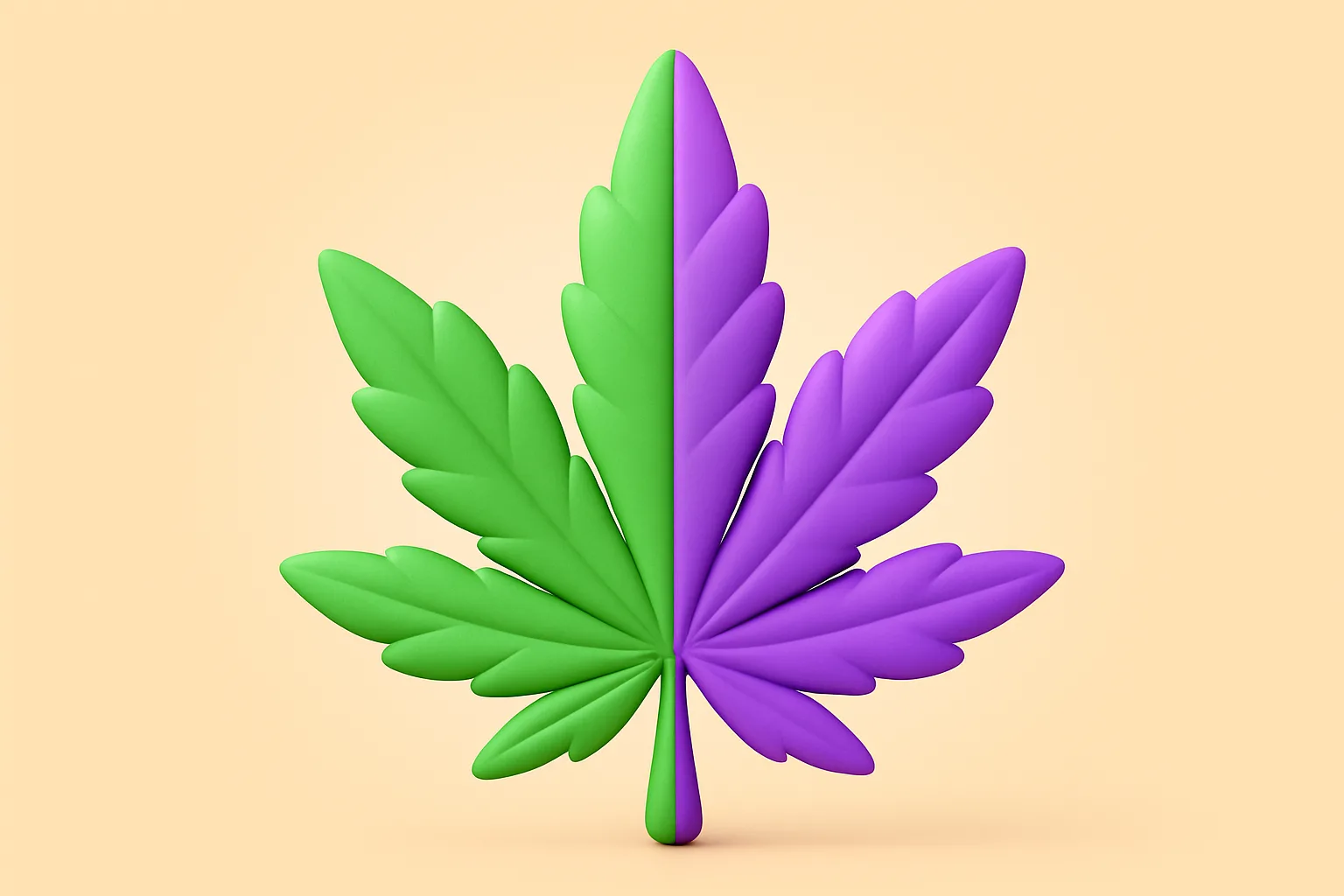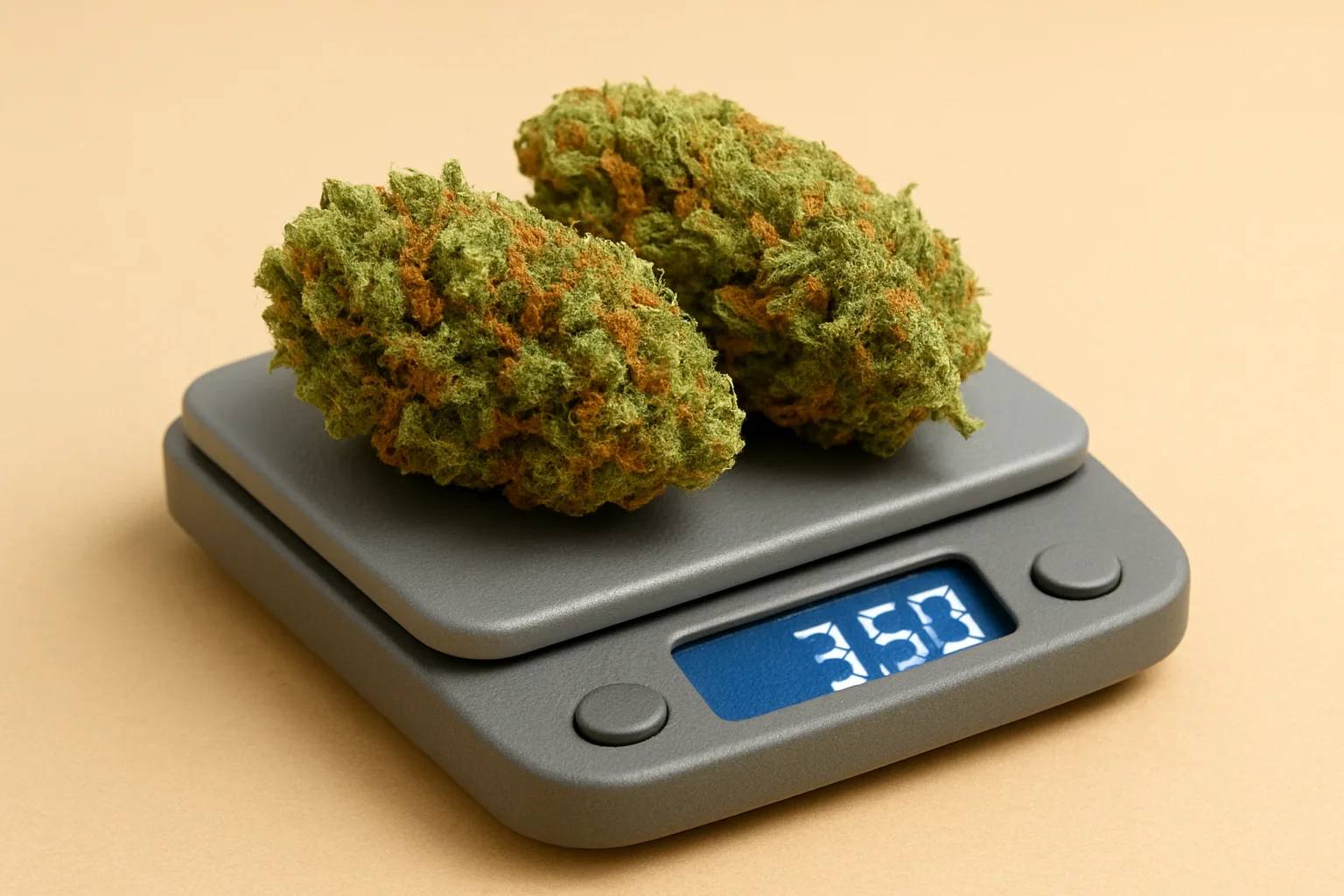

When you hear people talk about high-THC cannabis, it’s usually in reference to products with THC levels above 15%. But what does that really mean for your experience? At Shangri-La, we believe that understanding potency helps you to feel confident about your choices.
But why even dabble with high-THC products to begin with? They can offer more substantial psychoactive effects and potential therapeutic benefits, but the right option depends on your comfort level and goals.
Let’s walk through what counts as high THC, how THC potency is measured, and what to expect when exploring stronger cannabis strains or products.
The threshold for high-THC cannabis usually starts around 15% THC for flower. As a reminder, THC is the primary psychoactive compound in the cannabis plant. On cannabis industry platforms like Weedmaps or Leafly, however, you may even see flower described as high THC only when it reaches an average THC level of 20% or more. For other cannabis products like extracts, the bar is much higher; many consider them “high THC” once they hit 60% THC or above.
These benchmarks are largely anecdotal rather than scientific. But depending on where you live, local regulations may define potency differently, effectively labeling certain products as high or low THC.
State rules around THC levels are far from consistent. For example, Connecticut caps flower at 30% THC and concentrates at 60%, while Illinois doesn’t cap potency but taxes products more heavily if they exceed 35% THC. Then there is Ohio, which has no statewide THC potency limits for flower or concentrates, and Missouri also skips potency caps.
Because of this patchwork of laws, what qualifies as “high THC” can change dramatically depending on where you shop. And remember, thresholds vary by product type; flower, concentrates, and edibles each have their own definitions of potency.
The only way to understand how strong a cannabis product really is is by lab testing. In every state where cannabis is legal, testing for THC potency isn’t optional; it’s required by law. These tests ensure that what’s on the label matches what’s in the package, giving you an accurate way to predict the effects.
One of the most commonly used methods in the industry is high-performance liquid chromatography (HPLC). This test works exceptionally well for flower because it can separate cannabinoids without heating them. That means it can measure both THCA (the raw, non-psychoactive form found in the plant) and THC (the form that creates psychoactive effects once activated by heat). Knowing both measurements gives you a clearer picture of your product’s potency.\
For concentrates and extracts, labs usually prefer to use gas chromatography (GC). This method involves heat, which converts THCA into THC, offering a “total potency” measurement.
It’s also worth noting that labs don’t stop at THC. Many will test for other cannabinoids and terpenes, as well as check for pesticides, heavy metals, and microbial contaminants. This broader analysis not only verifies strength but also helps ensure the product is clean and safe to consume.
The THC concentration in cannabis results from a complex mix of genetics, cultivation techniques, and environmental conditions. Different cannabis strains exhibit varied genetic traits that significantly influence their THC levels.
Moreover, advanced cultivation methods and optimal environmental conditions can enhance THC production, ultimately affecting the THC levels of the final product.
But let’s get into the details for more context.
Genetics are the foundation of THC concentration in cannabis. Each strain comes with its own unique blueprint, which largely determines how much THC the plant can produce. Many strains are intentionally bred to maximize potency, passing down traits that consistently result in higher THC levels. Others naturally lean toward lower THC and may instead emphasize different cannabinoids.
This genetic variation is why certain strains reliably test at higher THC percentages; it’s just part of their lineage. While cultivation practices and environment still matter, genetics set the ceiling for how potent a strain can become.
Beyond genetics, how a cannabis plant is grown is another factor that affects THC levels. Modern cultivation techniques (think: hydroponic systems and carefully controlled environments) give growers the ability to fine-tune every detail. With the right balance of nutrients, light, and airflow, plants can reach their full potential, often producing significantly higher THC levels than their genetic profile typically averages.
Environmental factors add another layer of complexity. For example, light intensity during the flowering stage directly affects THC production, while temperature management in the final weeks can boost potency even further. Humidity control also shapes the cannabinoid profile.
Interestingly, a little bit of environmental stress can push cannabis to produce more cannabinoids and terpenes as a defense mechanism. When a cultivator knows how to tap into these environmental levels, they can push the plants to increasingly higher levels of THC.
Careful cultivation paired with optimal environmental conditions and the occasional well-managed stressor helps growers produce cannabis with higher THC levels and more dynamic effects.
High-THC cannabis products are loved so much because of their strength and intensity. They can deliver a more noticeable experience with smaller quantities. For example, a single pull from a distillate pen may feel more potent than smoking an entire pre-roll. This efficiency is one reason many consumers view high-THC products as cost-effective, especially if they prefer bold, concentrated effects.
High THC also has applications for medical cannabis patients. Patients may turn to high-THC cannabis products for easing chronic conditions, such as ongoing pain or discomfort, as well as for supporting relief during acute flare-ups. It has also been explored for its potential to help with nausea, appetite changes, and muscle-related issues.
The same potency that makes high THC appealing for some people can also make it overwhelming for others. If you’re new to cannabis or sensitive to THC, the experience may feel stronger than expected, maybe even leading to a green out. Not everyone enjoys that intensity, which is why many consumers choose to balance their use with lower-THC products or those that combine THC with other cannabinoids, like CBD.
It’s also worth saying that with regular use, your body can build up a tolerance to THC, meaning that, over time, you may need more product to reach the same effect. It’s a slow creep, but it does happen. In rare cases, prolonged exposure to high THC can lead to cannabis use disorder.
High-THC cannabis has been studied for a range of medical applications, though the strength of the evidence varies. The most well-documented applications involve symptom management.
Evidence-supported medical uses for high-THC cannabis products:
Emerging areas of study include Tourette syndrome, fibromyalgia, PTSD, and migraines. Research into THC’s potential anti-inflammatory and neuroprotective effects is ongoing, particularly in connection with neuroinflammation and gut health.
While THC shows promise, it’s important to note that results can vary widely from person to person, and not all conditions have strong clinical backing yet. For many patients, the most consistent support remains in providing relief from nausea, stimulating appetite, managing chronic pain, and addressing muscle spasticity.
However you choose to use THC medicinally, it’s always important to work with your healthcare team to make the most appropriate choice for your life and condition.
High THC is fun, but it’s essential to approach it thoughtfully to avoid any unwanted side effects, such as anxiety, paranoia, or greening out. Remember, everyone’s tolerance is different. What feels manageable for one person might be too intense for another.
That’s why the best rule of thumb is to start low and go slow, giving yourself time to feel the effects before consuming more. If you are smoking or vaping, wait at least two hours before heading back for another session. If it’s an edible, you’ll want to wait a few more hours to make sure you don’t get hit with double the effects.
Again, if you’re new to cannabis or have health concerns, it’s always wise to check in with a healthcare professional before diving in.
Your environment matters, too. Using cannabis in a familiar and comfortable setting can help you feel more at ease, especially with high-THC cannabis products.
Try to avoid deep inhalations; they don’t necessarily enhance the experience and may make it harsher. And remember, cannabis affects reaction time and coordination, so it’s safest to wait several hours before driving or operating machinery.
Simple steps to keep in mind:
By taking a mindful approach, you can enjoy the bold effects of high THC while keeping the experience safe and manageable.
Did you know that over time, if not stored correctly, cannabis will lose its THC content? Exposure to air, light, heat, or humidity can cause cannabinoids to break down, resulting in a noticeable drop in potency.
To avoid that, it’s best to store your high-THC cannabis products in airtight containers, ideally made of amber or opaque glass that shields them from light. For long-term storage, vacuum sealing can go a step further by creating an oxygen-free environment that extends shelf life.
Temperature and humidity also matter. Dried cannabis stays at its best when stored at 60–70°F with relative humidity between 55–62%. Too much heat or direct sunlight can dry it out or degrade cannabinoids, while excess moisture can compromise quality. Many people throw in a humidity control pack to keep flower in the right zone without constant monitoring.
Quick storage tips:
For those who enjoy bold effects, you’ll want to skip low-THC strains and head straight for the high-THC options. These strains are known for their strong effects, not to mention their tasty flavor profiles and often world-famous genetics. While the THC percentage can vary depending on how and where a cannabis plant is grown, here are a few popular varieties that consistently test on the higher end:
Sometimes referred to as the “Don of OGs,” this indica-dominant hybrid has earned a legendary status thanks to high THC levels that can push up to 34%. Its dense, resinous buds carry an earthy, pine-forward aroma with subtle notes of grape and herbs. Known for its high THC percentage, Godfather OG is often chosen by consumers who want the strongest possible option in a smaller dose.
This strain is a balanced hybrid that typically tests as high as 29% THC. Ghost OG brings together citrus, pine, and floral notes, creating an uplifting yet grounding experience. It’s often celebrated for its versatility, strong enough for seasoned consumers but still approachable when enjoyed in moderation.
With a THC percentage of around 27%, Bruce Banner #3 is named after the alter ego of the Hulk, and for good reason. Its bright green buds deliver a powerful punch, paired with diesel, berry, and sweet citrus flavors. This high-potency hybrid has become a staple for those seeking a strain that hits hard and fast.
Sticky and strong, GG4 is beloved for both its resin-heavy buds and its THC content, which often lands between 25–28%. Expect a pungent, earthy aroma with hints of pine and chocolate. Consumers gravitate to GG4 for its heavy-handed intensity, making it a long-time favorite among high-THC enthusiasts.
This hybrid is just as sweet as its name suggests, with a dessert-like aroma of berries, citrus, and cream. Averaging around 26% THC, Gelato balances potency with a flavorful smoking experience. It’s a go-to for consumers who want a strain that’s both strong and enjoyable on the palate.
Bright and citrus-forward, Mimosa combines fruit-punch sweetness with THC levels that can climb into the mid-20s. Its lively aroma and flavor profile make it popular for those who want a flavorful, high-THC option that stands out from more traditional, earthy strains.
A strain that lives up to the hype, Runtz is admired for its candy-like sweetness and colorful buds. With THC often landing between 25–29%, it offers a balance of potency and vibrant flavor. This modern classic has quickly become a favorite for consumers chasing both taste and strength.
Carrying a creamy berry aroma with notes of citrus and skunk, Sunset Sherbet is a flavorful strain with THC percentages in the mid-20s. Its striking bag appeal and sweet, dessert-inspired flavor profile make it a standout among high-THC choices.
Understanding THC levels in cannabis is important for both recreational consumers and those exploring medicinal cannabis. Now you have the tools to explore high THC, understand that THC concentration is measured, and are aware of the key factors affecting THC levels, from genetics and cultivation techniques to storage conditions.
Knowing the THC concentration of the products you consume, and the deeper layer of what factors affect THC levels, ensures that you’ll stay safe and keep the experience enjoyable.
And remember, when you shop with Shangri-La, our knowledgeable team is always ready to answer your questions and help you find the right product for your comfort level and goals.
High THC in cannabis is generally considered to be over 15% THC content, but this can vary by product type and local laws. If you’re looking for a potent experience, aim for strains that fall into this category!
THC potency in cannabis products is commonly measured by lab tests like high-performance liquid chromatography (HPLC) and gas chromatography (GC), which determine the THC content based on the product’s total weight. This ensures you’re getting an accurate idea of the potency of what you consume.
High-THC cannabis is great for easing chronic pain, helping with nausea from chemotherapy, boosting appetite, and managing muscle spasms. It offers some solid therapeutic benefits if you’re looking for relief.
To keep your high-THC products potent, store them in airtight containers, ideally vacuum-sealed, and maintain humidity between 55% and 62% with temperatures around 60–70°F. This will help preserve their quality and strength.
If you’re looking for popular high-THC strains, you can’t go wrong with Godfather OG, Bruce Banner #3, or Runtz. They pack a punch and offer unique effects!

If you’re new to cannabis, the flood of unfamiliar words can feel completely overwhelming. From technical terms like “cannabinoids” to casual slang tossed around at the dispensary like “dab” or “terp,” it’s easy to feel lost. No matter your starting point, at Shangri-La, our mission is to empower you. Whether you’re an OG cannabis lover […]

When you step into a dispensary or shop online for cannabis, you’ll notice that everything revolves around weight. Whether you’re buying a single pre-roll or stocking up on flower for the month, understanding cannabis measurements is key to getting the right amount for you and staying within legal limits. In this guide, we’ll break down […]
Shangri-La Proudly Serves: Connecticut, Illinois, Kentucky, Missouri and Ohio.